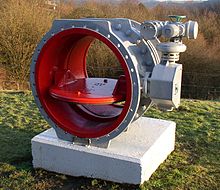Gear motor

A gear motor is a combination of a motor and a gearbox .
technology
The gearbox causes the (outer) output shaft to rotate at a lower speed and greater torque than the (inner) motor shaft. The motor and the gearbox form a unit and sometimes have a common housing.
Because electric motors have smaller masses of copper and iron with the same nominal power and higher speed, a reduction gear is usually useful. The same applies to internal combustion engines.
In 1927 Albert Obermoser designed an early electric geared motor, the patented countershaft motor.
Direct drives , d. H. Drives operating without a gearbox, however, also have advantages. There is much less play and there are no losses in efficiency of the transmission. The motor spindle is an example .
The step-up or step-down "i" of a gear unit is the speed ratio of the input speed to the output speed. In addition to "i", the efficiency, the maximum torque at the output, the backlash, the maximum speed and the maximum axial and radial shaft load (force) are important parameters of a geared motor.
Gear types (single or multi-stage) that are mainly used in gear motors:
- Worm gear : axis of the output shaft perpendicular to the motor axis of rotation
- Spur gear : Axis of the output shaft parallel, but offset to the motor axis of rotation
- Planetary gear : the axis of the output shaft is the same as the motor axis of rotation
- Bevel gear : Axis of the output shaft perpendicular to the motor axis of rotation
A distinction must also be made between quarter turn actuators and rotary actuators. With a rotary drive, the driven shaft rotates as often as required, with a rotary drive less than one revolution.
A characteristic of the geared motors is whether they are self-locking or not, i.e. whether the output shaft can rotate when the motor is de-energized. This is often the case with spur gears and planetary gears with a low reduction ratio. Worm gears with a reduction ratio greater than i = 25 are usually self-locking.
Some gear motors are brake motors. With these, the motor shaft is equipped with a mechanical brake for fast braking. The gear reduction produces a correspondingly increased braking torque on the drive shaft. However, this torque must be dimensioned so that it does not overload the transmission. Because after a gear breakage, the machine can continue to run despite the motor being stopped. Gear brake motors are required for a quick stop, for example in machine tools and packaging machines.
Gear motors are used, for example, for fittings , windshield wipers, robots, feed drives, roller shutters and blinds. They are often equipped with a standardized flange with which they can be connected via a coupling lantern with a housing to be connected and a coupling, e.g. B. a metal bellows coupling or a corrugated pipe coupling, can be connected to the shaft to be driven. Sometimes gear motors have a detachable handwheel so that the component to be driven can also be operated by hand if necessary.
literature
- Bonfiglioli Riduttori (Ed.): Manual of Gearmotors . Springer, Berlin 1997, ISBN 3-540-60977-6 .
Web links
- Geared Motor & Geared Motors | SEW-EURODRIVE
- NORD - NORD - gear units and geared motors from Nord Drivesystems
- Geared motors at reichelt elektronik
